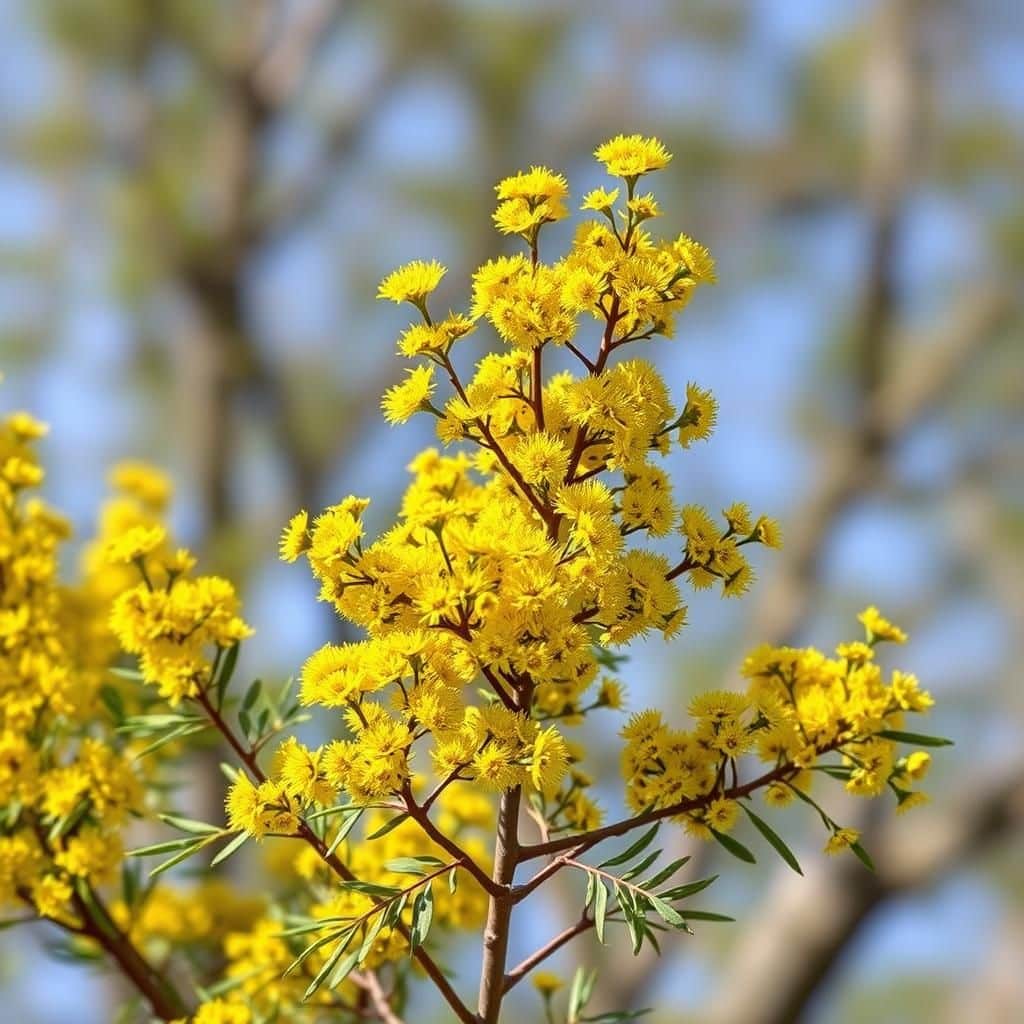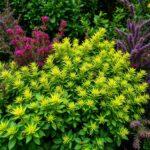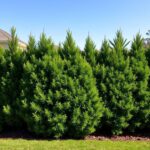All You Need to Know About Golden Wattle Acacia Pycnantha: Care, Characteristics, and Benefits

Golden Wattle (Acacia pycnantha) is not only Australia's national floral emblem but also a remarkable plant known for its vibrant yellow flowers and resilience. This article delves into the essential aspects of Golden Wattle, covering its care requirements, distinct characteristics, and numerous benefits. Whether you're a seasoned gardener or a novice looking to enhance your landscape with this striking species, understanding how to cultivate and appreciate Golden Wattle will enrich your gardening experience. Join us as we explore the fascinating world of Acacia pycnantha and uncover why it deserves a place in gardens and natural habitats alike.
Understanding the Golden Wattle (Acacia pycnantha)
The Golden Wattle (Acacia pycnantha) is a native Australian plant renowned for its striking appearance and ecological significance. This deciduous shrub or small tree can grow up to 8 meters in height and is easily recognized by its bright yellow flowers that bloom in spring, providing a vibrant display that attracts pollinators. The leaves of the Golden Wattle are actually phyllodes, which are flattened leaf stems that perform the function of leaves, giving the plant a distinctive look. Beyond its aesthetic value, the Golden Wattle plays an essential role in local ecosystems, helping to stabilize soils and providing habitat for various wildlife species, while also being embraced as a symbol of Australian identity.
Botanical Characteristics
Golden Wattle is characterized by its unique botanical features. The plant's leaves are modified into phyllodes, which are elongated and flat structures that can measure up to 20 cm in length. The striking yellow flowers form in clusters, signaling the arrival of spring and offering sustenance to various pollinators, including bees. The bark of the tree is smooth and has a greyish color that darkens with age. These characteristics not only make the Golden Wattle visually appealing but also contribute to its resilience in various habitats.
Habitat and Distribution
Acacia pycnantha is commonly found in open forests, woodlands, and grasslands across southeastern Australia, particularly in regions such as Victoria and New South Wales. It thrives in well-drained soils and can tolerate a variety of soil types, including sandy and clayey substrates. The plant prefers situations with full sun exposure but can also adapt to partial shade, making it an important species in both natural and cultivated areas. Its widespread presence in various ecosystems enhances biodiversity and provides critical functions within these environments.
Cultural Significance
The Golden Wattle holds a special place in Australian culture. It was officially designated as Australia's national floral emblem in 1988, and it symbolizes the spirit and resilience of the Australian people. Various indigenous communities also have cultural ties to the plant, utilizing its flowers and seeds in traditional practices. The presence of the Golden Wattle during significant events, such as ANZAC Day, reinforces its role as a symbol of remembrance and national pride.
See also:
Ecological Importance
The ecological importance of the Golden Wattle cannot be understated. This species contributes to soil health by fixing nitrogen through symbiotic relationships with bacteria in root nodules, enriching the soil and promoting growth in surrounding plants. Additionally, its flowers provide nectar for bees, while its leaves serve as food for various insects and larvae. The plant can also create shelter and nesting sites for small mammals and birds, thus playing a vital role in maintaining biodiversity within its habitat.
Uses and Applications
The versatility of the Golden Wattle extends to various uses and applications. Its tough and durable wood is suitable for making furniture, tools, and other items, while the bark has been traditionally used for making cordage and textiles. Moreover, the plant's striking flowers are often used in ornamental landscaping and are increasingly popular in the cut flower industry. In recent years, research into the culinary potential of its seeds and extracts for health benefits has also gained attention, highlighting the Golden Wattle’s multifaceted role in both natural and human systems.
| Characteristic | Description |
|---|---|
| Height | Up to 8 meters |
| Flower Color | Bright yellow |
| Leaf Type | Phyllodes |
| Habitat | Open forests, woodlands |
| Significance | National floral emblem of Australia |
Understanding the Ideal Growing Conditions for Golden Wattle
The Golden Wattle (*Acacia pycnantha*) thrives in a variety of environments, but it particularly flourishes in areas with full sun and well-draining soil. These conditions support its growth, allowing the plant to show off its bright yellow flowers during the blooming season, which can attract a plethora of beneficial pollinators. It is also essential to ensure that the plant is not exposed to prolonged frost or excessive humidity, as these conditions can harm its health and inhibit growth. Additionally, integrating native plant practices can encourage a flourishing ecosystem, ensuring the sustainable growth of this beautiful Australian native.
Care Guidelines for Golden Wattle
Caring for the Golden Wattle involves providing adequate water, especially during the initial stages of growth. It's important to allow the soil to become slightly dry between watering sessions, as this plant is sensitive to overwatering. Fertilization should be approached with care; using a low-phosphorus fertilizer during the growing season can support its health. Regular pruning may also be beneficial, helping maintain an attractive shape while encouraging new growth and denser foliage.
Characteristics of Golden Wattle
The distinct characteristics of *Acacia pycnantha* make it a standout in gardens and landscapes. This medium-sized tree can reach heights of up to 10 meters and features finely divided, feathery leaves that offer a delicate appearance. Its most striking feature is the round, fluffy yellow flower clusters that bloom from late winter to spring, creating a stunning display. These flowers are not only visually appealing but also have significant cultural and historical importance in Australia, symbolizing national identity.
See also:
Benefits of Growing Golden Wattle
Growing Golden Wattle offers numerous benefits for gardeners and the environment alike. As a member of the Legume family, this plant has the ability to improve soil quality through nitrogen fixation, enhancing nutrient availability for surrounding plants. Furthermore, its attractive flowers provide essential resources for local pollinators, contributing to overall ecosystem health. The plant's exceptional drought resistance makes it suitable for xeriscaping, creating sustainable landscapes that conserve water.
Pests and Diseases Affecting Golden Wattle
While *Acacia pycnantha* is generally hardy, it can be susceptible to various pests and diseases. Common issues include aphid infestations, which can weaken the plant and lead to leaf curling. Fungal diseases such as root rot can occur, particularly if the plant is exposed to waterlogged conditions. Regular monitoring and the implementation of organic pest control methods can mitigate these risks, ensuring the longevity and health of the Golden Wattle.
Landscaping Ideas with Golden Wattle
Incorporating Golden Wattle into landscaping can create vibrant and eye-catching displays. Its bright yellow blossoms can serve as a focal point in native gardens, enhancing the visual appeal while attracting wildlife. Additionally, when planted in groups, these trees can provide valuable shade and habitat for birds and insects. Pairing Golden Wattle with other Australian natives can create a harmonious ecosystem that not only supports local biodiversity but also offers year-round visual interest.
Questions from Our Readers
What is the golden wattle (Acacia pycnantha)?
The golden wattle, scientifically known as Acacia pycnantha, is a species of flowering plant that is native to Australia. It is renowned for its beautiful golden yellow flowers and is a significant symbol of Australian identity. The tree can grow up to 8 meters in height and is known for its hardy nature and adaptability to various soil types.
What are the uses of golden wattle?
Golden wattle has several uses, including its role in landscaping and ornamental gardening due to its striking flowers. It is also valued for its timber, which is used in furniture and construction. Additionally, the leaves and bark have been utilized in traditional medicine by Indigenous Australians for various therapeutic purposes.
See also:
Is golden wattle environmentally friendly?
Yes, golden wattle is considered environmentally friendly as it is a native species that supports local wildlife and biodiversity. Its nitrogen-fixing capabilities improve soil quality, making it beneficial for surrounding plants. However, caution is advised in regions outside its native habitat, as it can become invasive.
How can I care for a golden wattle plant?
To care for a golden wattle plant, ensure it is planted in a location with full sun and well-drained soil. Watering is important, especially during dry spells, but be careful not to overwater. Pruning can help maintain its shape and encourage healthy growth. Fertilizing with organic materials can also enhance its flowering potential.

If you want to read more articles like All You Need to Know About Golden Wattle Acacia Pycnantha: Care, Characteristics, and Benefits, we recommend you check out our Shrubs category.
Leave a Reply
Related Articles